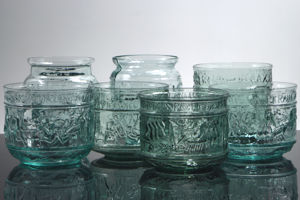 Home
Gallery
Contact
Events & Projects
Projects: 2019 On
Film & TV
Archive & Links
Home
Gallery
Contact
Events & Projects
Projects: 2019 On
Film & TV
Archive & Links

 Home
Gallery
Contact
Events & Projects
Projects: 2019 On
Film & TV
Archive & Links
Home
Gallery
Contact
Events & Projects
Projects: 2019 On
Film & TV
Archive & Links
|

|
Ordering, Postage, Payment, Import Duty & Safety Roman and Other Ancient Glass Mould-blown Beakers
These unusual and attractively decorated vessels were fairly common during the second half of the 1st century AD, and have been found throughout the western provinces of the Roman Empire, including Britain.
Circus beakers exist in either cylindrical or ovoid forms, and their decorations conform to a handful of basic designs:
Four-horse chariots (Quadrigae) are usually depicted on cylindrical beakers with a single or double frieze. Single frieze scenes usually show four quadrigae racing in a circus, or race track (hence the name “circus beakers”), with the winner holding aloft a palm or victory wreath. The double frieze varieties also show a four-chariot race in the lower section, whilst the middle strip represents the Spina, the central barrier of the race track, which was decorated with three vast conical Metae (turning posts) at each end, lap counters in the forms of seven eggs and seven dolphins, a throne, altars, obelisks and statues. Names of the charioteers were included in a smaller third frieze immediately below the rim of the cup, the winner often having the suffix "AV" ("ave"- "hail"), or “VIC”, whilst the other competitors' names end with "VA" ("vale"-"farewell", or possibly "vade"-"go"). (Gegas' name has the suffix “VA” on the lamp mentioned below).
The most famous race track was the Circus Maximus in Rome, where, during the reign of Caligula (37-41 AD), as many as thirty-four chariot races were held daily.
The beaker 047d from Colchester is featured as the vital clue in the novel in Caroline Lawrence's 'Roman Mysteries' series, 'The Charioteer of Delphi'. This book contains what is currently the most accurate and vivid description of both the Roman races and the daily workings of Circus Maximus to be found anywhere.
Gladiatorial combat scenes occur on cylindrical beakers as a single frieze, or combined with two-horse chariot (Bigae) racing scenes on some ovoid vessels. On cylindrical beakers, four pairs of gladiators armed with helmets, swords and shields (and less frequently, tridents) are shown in various stages of conflict: face-toface combat, wounded, victorious, submitting (by raising the left hand in defeat), running away and slain. Such clashes took place in amphitheatres, and were a very popular form of entertainment.
As on the chariot beakers, the gladiators' names (mostly heroic nicknames), recur on different designs, suggesting that they recall memorable combats. Petraites ('Rocky') is named both in the Satyricon of Petronius and on an inscription at Pompeii, whilst Spiculus ('Sting' - a known favourite of Nero), Columbus ('Dove') and Proculus ('Hammer') are mentioned by the historian, Suetonius.The fact that the same competitors' names recur on most of these vessels suggests that they were only produced for a relatively short period (Claudio-Neronian), and it is strange that later generations of gladiators and charioteers were not represented on similar glass cups, as they continued to be on mosaics, ceramics and other media. This may be due to changes in taste on the part of the buying public, but another possible explanation may be the loss of the particular skills necessary to create the archetypes and moulds for these, some of the finest and most elaborate of Roman mould blown vessels.
Our beakers are blown into a three-part mould, as were the original Roman vessels. The waste glass is cut off above the rim, which is then ground and polished.Home Gallery Contact Events & Projects Projects: 2019 Onwards Film & TV Archive & Links